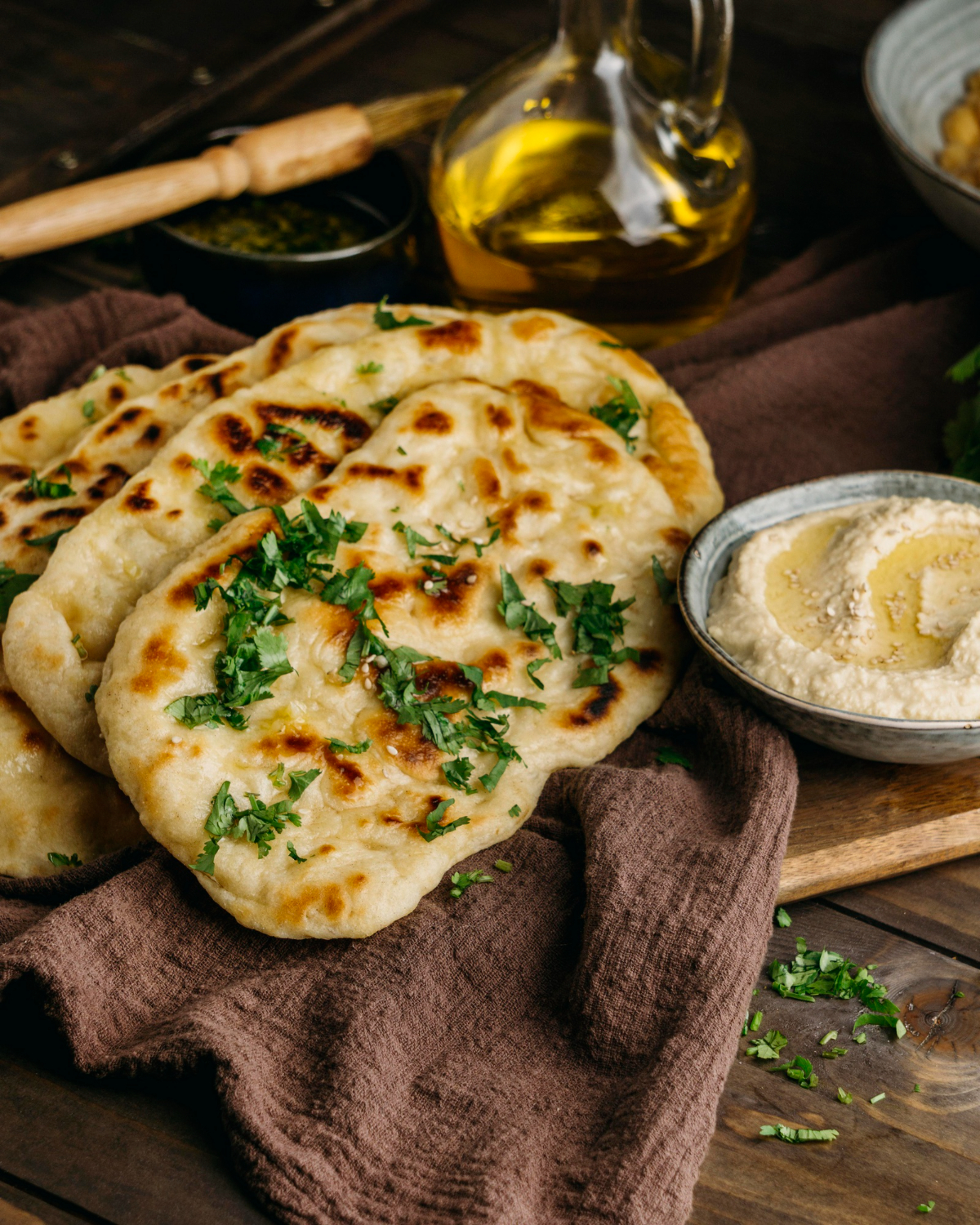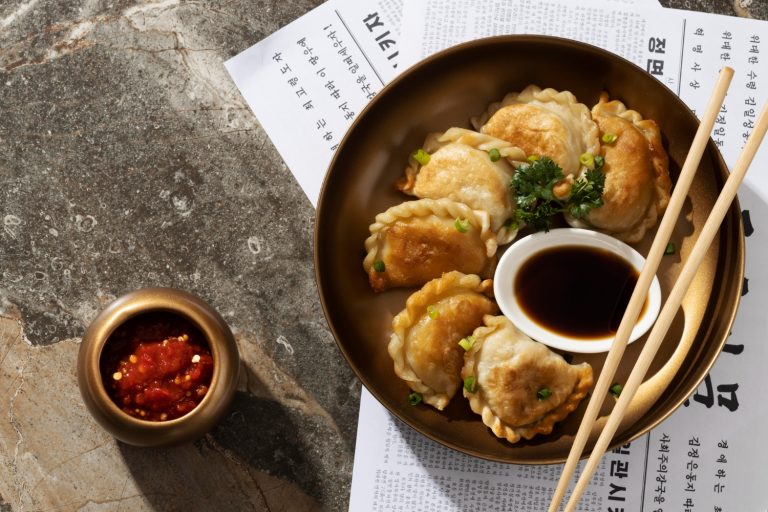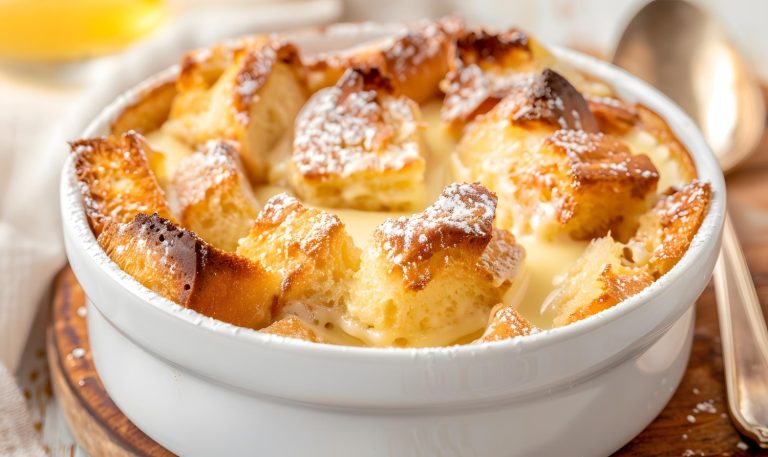Sourdough Naan Recipe: A Fusion of Traditional Indian Flatbread & Artisanal Fermentation Recipe
This artisanal twist on classic naan bread marries the tangy complexity of sourdough with the rich tradition of Indian flatbreads. The slow fermentation develops deep flavors while creating an exceptionally tender crumb structure. When cooked properly, these naans develop beautifully charred blisters and a pillowy texture that makes them perfect for scooping up curries or enjoying as a standalone bread.
Time & Yield
- Active Prep Time: 45 minutes
- Fermentation Time: 4-6 hours
- Cook Time: 20-25 minutes
- Total Time: 5-7 hours
- Servings: 8 large naans (about 8 inches each)
- Difficulty: Intermediate
Equipment Needed
- Large mixing bowl
- Kitchen scale (recommended for accuracy)
- Rolling pin
- Cast iron skillet, tawa, or heavy-bottomed pan
- Clean kitchen towels
- Dough scraper
- Small bowl for ghee
Ingredients
For the Dough
- 300g (2½ cups) unbleached all-purpose flour
- 150g (⅔ cup) active sourdough starter (100% hydration)
- 120ml (½ cup) whole milk, warmed to 95°F (35°C)
- 60g (¼ cup) full-fat plain yogurt
- 30ml (2 tbsp) olive oil
- 8g (1½ tsp) fine sea salt
- 6g (1½ tsp) sugar
- 3g (½ tsp) baking powder
For Finishing
- 60g (4 tbsp) ghee or melted butter
- Optional toppings:
- Nigella seeds
- Minced garlic (2-3 cloves)
- Fresh cilantro, finely chopped
- Butter for brushing
Detailed Instructions
Preparing the Dough (Morning)
Feed your sourdough starter 4-6 hours before making the dough to ensure peak activity. The starter should be bubbly and pass the float test.
In a large mixing bowl, combine:
- Warm milk
- Active sourdough starter
- Yogurt
- Sugar Whisk until well combined and no starter lumps remain.
In a separate bowl, mix:
- All-purpose flour
- Salt
- Baking powder
Gradually add the dry ingredients to the wet mixture, incorporating with your hands or a wooden spoon until a shaggy dough forms.
Begin kneading:
- Turn onto a clean, unfloured surface
- Knead for 8-10 minutes until smooth and elastic
- Add olive oil in the final 2 minutes of kneading
- The dough should pass the windowpane test
First Rise:
- Place in an oiled bowl
- Cover with plastic wrap or damp towel
- Let ferment for 4-6 hours at room temperature (68-72°F/20-22°C)
- The dough should double in size
Shaping and Cooking (Afternoon/Evening)
Prepare Your Station:
- Heat cast iron skillet over high heat
- Set up ghee for brushing
- Have clean kitchen towel ready
- Lightly flour work surface
Divide and Pre-shape:
- Turn dough onto a lightly floured surface
- Divide inteight 8 equal portions (about 85g each)
- Shape each into smooth balls
- Rest 15 minutes covered
Final Shaping:
- Roll each piece into an oval shape
- Aim for ¼ inch thickness
- Maintain uneven surface for authentic texture
- Dust off excess flour
Cooking Process:
- Place naan on hot skillet
- Cook for 1-2 minutes until bubbles form
- Flip and cook for 1-2 minutes more
- Brush with ghee immediately
- Stack and wrap in cloth to keep warm
Storage Guide
Room Temperature:
- 2 days in an airtight container
- Wrap in foil or cloth
- Reheat on skillet
Refrigeration:
- Up to 1 week
- Store in a sealed bag
- Remove air to prevent drying
Freezing:
- Up to 3 months
- Layer with parchment paper
- Thaw in refrigerator
- Reheat in 350°F oven for 5 minutes
Detailed Nutrition Facts (per naan)
- Calories: 180
- Total Fat: 4g
- Saturated Fat: 1.5g
- Cholesterol: 5mg
- Sodium: 390mg
- Total Carbohydrates: 32g
- Dietary Fiber: 1g
- Sugars: 1g
- Protein: 5g
- Iron: 2mg
- Calcium: 25mg
Advanced Variations
Garlic Naan
- Add 2-3 minced garlic cloves to dough
- Brush with garlic butter
- Sprinkle with cilantro
Whole Wheat Version
- Replace 150g AP flour with whole wheat
- Increase hydration by 10%
- Reduce fermentation by 1 hour
Stuffed Naan
Potato Filling:
- 2 mashed potatoes
- 1 tsp cumin seeds
- 1 chopped green chili
- Fresh cilantro
Paneer Filling:
- 1 cup crumbled paneer
- ½ tsp garam masala
- Minced green chilies
Essential Process Tips
Temperature Control:
- Maintain dough at 75-80°F
- Use warm milk for proper fermentation
- Heat pan until water droplets dance
Hydration Management:
- Adjust flour/liquid ratio based on climate
- The dough should be soft but not sticky
- Use minimal flour when rolling
Texture Development:
- Proper kneading develops gluten
- Allow full fermentation time
- Don’t overwork when shaping
Traditional Pairing Suggestions
Rich Curries
- Butter Chicken
- Dal Makhani
- Palak Paneer
- Malai Kofta
Light Accompaniments
- Raita (cucumber yogurt)
- Mint Chutney
- Pickled Onions
- Fresh Garden Salad
Ingredient Substitutions
Dairy Alternatives
- Milk: Oat milk or almond milk
- Yogurt: Coconut yogurt or silken tofu
- Ghee: Olive oil or vegan butter
Flour Options
- All-purpose: Bread flour (add 2% more liquid)
- Partial whole wheat: Max 50% replacement
- Gluten-free: Not recommended for this recipe
Frequently Asked Questions
Why is my naan tough and chewy?
- Common causes:
- Overworked dough
- Insufficient fermentation
- Too much flour when rolling Solution: Handle the dough gently, ensure proper fermentation, and use minimal flour
- Common causes:
Can I make this without a sourdough starter?
- Not recommended for this specific recipe
- Flavor and texture rely on fermentation
- Consider a traditional yeast naan recipe instead
Why isn’t my naan developing charred spots?
- Pan likely not hot enough
- Solution: Heat pan for 5+ minutes on high
- Test with water droplets
- Ensure proper dough hydration
How do I know when my dough is fermented correctly?
- Should double in size
- Passes finger poke test
- Smells pleasantly source surface shows small bubbles
Historical Food Fact
Ancient Sanskrit texts from 2500 years ago mention naan-like bread cooked in earthen ovens, but modern naan as we know it evolved in the royal kitchens of Delhi during the Mughal era (16th century). A ddingf yeast and eggs to the dough was a Persian influence, making naan a true fusion food centuries before fusion cuisine became trendy!
Pro Tips for Perfect Results
- Use filtered water for starter feeding
- Maintain consistent room temperature
- Don’t skip the yogurt – provides tenderness
- Roll uneven shapes for an authentic look
- Keep cooked naans wrapped until serving
- Brush with ghee while hot






